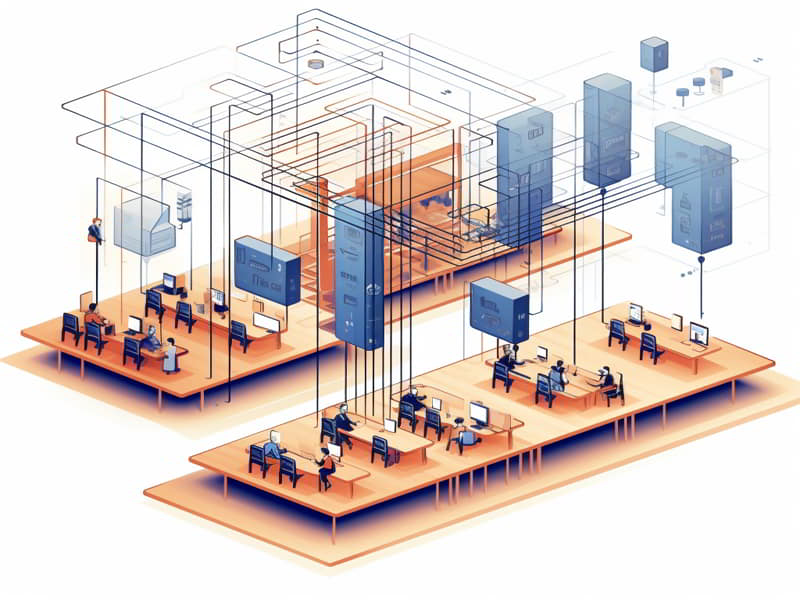Apache NiFi Interview Questions
Whether you are new to NiFi or have been working in it for awhile – this blog can be a starting point in getting ready for interviews!
Apache NiFi is an open-source platform designed to simplify data integration by offering easy ways of creating, installing and controlling data pipelines.
It featuresa graphical user interface (GUI) and programming interfaces (APIs) explicitly designed to support creating apps that integrate data.
This blog post on Apache NiFi interview questions covers all of its key ideas and technologies used within its platform.

1. What is Apache NIFI?
Apache NIFI is a Java application that simplifies creating, implementing, installing, and providing solutions for various applications.
It is designed to be straightforward, with a few options for users to work on their experiences.
Apache NIFI aims to create an integrated web server that can handle complex systems and provide the necessary information from the client for a secure system.
2. How does Apache NIFI work?
Apache NIFI requires a web client, which connects to a web server.
However, the web server only has some of the necessary information and depends on other servers like Oracle or different types of servers.
To create a service server, the client calls the service server, which has this integration capability.
Maintaining these services can be complex and time-consuming, so administrators must clearly understand the tasks required.
3. Advantages of using Apache NIFI?
The main advantage of Apache NIFI is its availability and configuration, which has improved significantly over the past five years.
Another advantage is the architecture, which provides various services and qualifications.
Apache NIFI is a powerful tool for creating, implementing, installing, and providing solutions for multiple applications.
It is designed to be user-friendly and affordable and offers a comprehensive solution for managing complex systems.
4. What is Apache Naifa?
Apache Naifa is a system that automatically uses data flow into different platforms, allowing administrators and teams to work together.
It provides benefits like data flow control and resolving issues with data formats, motors, and devices.
The platform is resilient to different types of responses and process elements, allowing for control over data and transforming it into attributes. It is compatible with hundreds of operating system technologies and supports ample data-sharing information.
5. How does Apache Naifa work?
Apache Naifa focuses on fundamental concepts such as the flow file, process, and group of functions.
The flow file represents the minimum amount of information that can be processed in the system, while the process is a way to get this flow file.
The connection between processes is crucial, with each link having a call that depends on the rate and logic of the process.
The architecture of Apache Naifa includes system operators in the virtual world, which consists of the controller of flows, processors, and extensions.
The virtual world has three phases: the repository of all flow files, the content, and the process.
6. What are Apache Naifa’s capabilities?
Apache Naifa is suitable for handling data transfer from various and heterogeneous systems while performing basic ETL in between.
It can handle data transfer from multiple systems and basic ETL. The NIFI flow system aims to deliver data from people through various groups, including directories, processors, and attributes.
These processes can be used with different technologies such as apps, computers, cloud, servers, etc.
Methods can convert base formats to single formats, and attributes can be specific to a processor.
7. How is Apache Naifa different from Apache NIFI?
Apache Naifa focuses on fundamental concepts such as the flow file, process, and group of functions.
At the same time, Apache NIFI aims to create an integrated web server that can handle complex systems and provide the necessary information from the client for a secure system.
Apache Naifa is suitable for managing data transfer from various and heterogeneous systems while performing basic ETL in between, while Apache NIFI can handle data transfer from multiple systems and basic ETL.
8. What are some of the tools available for creating processes in Apache Naifa?
Various tools are available for creating processes in Apache Naifa, such as Excel and CSEV, which can be used via configuration.
The process can be scheduled at a specific time, and the data generated will be stored in a file.
9. To what extent does Apache NIFI differ from competing data distribution systems?
The power of NIFI lies in its ability to quickly create flows and make transformations and routing decisions, making it a popular choice for clients and customers.
By understanding the capabilities and flexibility of Apache Niffy, users can effectively manage their data and improve their overall business operations.
10. Is Apache NIFI an open-source data distribution?
Apache NIFI is an open-source data distribution that can start with simple workflows and grow to complex ones with just a few clicks.
It provides a way to move data from one system place to another, making it easier to create complex data with a few clicks.
11. How exactly does data management work?
Data management involves moving data from one system to another and processing it as it flows through, performing ETL, routing the data, and making decisions.
12. What is expression language helpful for?
The expression language is helpful for data routing, transformation, and system media. It allows for scalable directed graphs for these purposes.
13. Where can data come from?
Data can come from various sources, such as JSON, databases, FTP, Hadoop, Kafka, and Elasticsearch.
14. Tell me about Apache NIFO.
Apache NIFO is a famous use case for IoT (Internet of Things), where it automates data flow between systems.
It uses a drag-and-drop interface to configure processes and delegate behind-the-scene processing to Apache NIFO.
15. How does one go about analysing real-life situations?
In real-world scenarios, the configuration of processes is crucial for Apache NIFO.
16. In Apache NIFI, what are the predefined settings for handling flow files?
Apache NIFI offers four default options for processing flow files: first in, first out, and vice versa. These configurations can be customised based on business problems.
17. Can you explain what Apache NIFI templates are?
Templates are pre-defined sets of processors, designs, and instructions that can be used to create templates for various business problems. Open-source templates available on the web can be used to create templates for complex flows and processes.
18. For what use is Apache NIFI not intended?
Apache NIFI is not meant for distributed computation, where complex distributed processing is required. Specific tools and technologies should be used instead.
19. Regarding Apache and NIFI, what is not their primary concern?
Apache and NIFI are not meant for complex event processing involving data from different systems and real-time decision-making. They should be used for batch time ETL operations, such as joining, summations, and aggregations.
20. What is a flow file?
A flow file is a food for the Apache NIFI system about the data and its definition, metadata, or attributes. It flows through the data flow created in Apache NIFI and includes two elements: the data itself, the content and key-value pair, and the characteristics of the data.

Apache NiFi Training

21. How does a flow file persist in Apache NIFI?
After creation, a flow file is persisted to the disk in Apache NIFI. Fault awareness comes into play as Apache NIFI indexes every Flow file that comes into Apache NIFI for those interested in a career in big data analytics.
22. What are the different types of scheduling in data processing?
Scheduling is a crucial aspect of data processing, with three main types: time-driven, event-driven, and cron-driven.
23. How does concurrency work in scheduling?
Concurrency determines the number of concurrent tasks scheduled for a processor and can vary depending on the processor’s workload.
24. How long does a flow file remain valid?
Flow file expiration is a feature in business systems that allows data to be processed if it is not processed within a specific timeframe.
25. Do you know what Apache NIFI is?
Attributes are metadata surrounding a flow file’s content, representing data information. They are key-value pairs with corresponding keys and values.
26. Where can I get the login configuration file for NIFI?
NIFI’s login configuration file is log back.XML, which manages all login operations.
27. Please tell me the purpose of the log back.xml file.
The log back.xml file contains pre-configuration and generates logs for various files.
28. By default, how many log files does NIFI store?
By default, there are three log files in the NIFI installation: app file, app log, NIFI-app.log, and NIFI user log.
29. How does logging help with debugging and monitoring in NIFI?
Logging helps debug and monitor NIFI by allowing users to see what went wrong and why the file processor failed.
30. What is the rolling policy class in the log file.xml file?
The rolling policy class specifies the maximum file size in the log file.xml file.
This blog seeks to assist job candidates who will be interviewing with Apache NiFi platforms like NiFi preparing for interviews for jobs that rely on using NiFi tools and ideas in practice, including giving an in-depth view of its main principles and tools that make up its platform as well as examples that showcase these ideas in action.
The Apache NiFi interview questions blog is an invaluable way to increase knowledge about this platform and its tools, with detailed explanations and real-life examples covering its leading ideas and technologies.
As such, this resource makes an ideal addition for anyone preparing to go into an interview related to technology.
31. How often is Kafka Producer put to use?
Kafka Producer is a processor that takes up three different data points and is used in real-time messaging and distributed service.
32. In managing Kafka infrastructure, how does Docker fit in?
Docker manages Kafka infrastructure by providing a single command to start all related tasks, such as a zookeeper, Kafka brokers, and Kafka connect registry.
33. What is the importance of learning Docker for microservices development?
Learning Docker is essential for microservices development as it provides easy Kafka infrastructure configuration and management.
34. For Apache Lite 5, what is Kafka’s purpose?
Kafka brokers and topics are used in Apache Lite 5 to create logically isolated storage units on Kafka for different purposes.
35. Can you explain how the retry flow file helps Kafka handle data failures?
The retry flow file manages failures in Kafka by retrying failed data up to three times. If the data fails after three attempts, it is sent to a put file or HDFS.
36. After the insert file procedure has succeeded or failed, how should it be terminated?
Terminating success and failure in the put file process is improper practice. Instead, files should be placed within the same minutes to produce an error scenario, and the error strategy should be used.
37. For what purposes was NIFI created?
NIFI is designed for batch-oriented and streaming use cases, handling billions of events per second. It can also move data from an SFTP server to an object store.
38. When compared to an ETL tool, how does NIFI differ?
NIFI is an ELT (Extract, Load, Transform) tool, while an ETL (Extract, Transform, Load) tool focuses on moving data as fast as possible. NIFI can handle unlimited data volumes and scales well horizontally and vertically.
39. What is the NIFI ecosystem?
The NIFI ecosystem includes the NIFI registry, which is a specialised Git system for managing CICD, managing work, and versioning. When working with NIFI, multiple environments are typically required.
40. In NIFI, what does “back pressure” mean?
Back pressure is a concept in NIFI that prevents over-accumulation of data in the connection. When upstream components reach certain limits, they stop so downstream elements can process the data.

Apache NiFi Online Training

Flow file attributes are used to make routing decisions, filter data, and audit the process, while profile content stores the provenance data generated from a flow file at a given time.
42. Can you tell me about NIFI’s lineage view?
The lineage view in NIFI allows for auditing, tracking, and replaying events that are no longer in the system. It tracks who was looking into the data and when it was archived.
43. Under NIFI, which parts are not allowed to be used?
Restricted components are available for specific scripts that NIFI can execute on the host where it is running. These components have dedicated permissions, which can be locked out if not used.
44. How are templates used in NIFI?
Templates were based on an XML flow description with rules. Instead, users can use download for definition to download a JSON version of their process or give a JSON file to the process group.
45. May I know which node in NIFI is the main one?
The primary node is the elected node when the cluster starts and is considered the primary node for some use cases.
46. What is Apache NIFI used for?
Apache NIFI is used in critical use cases across various industries, such as banks handling payment transactions. It is a tool for production with minimal intervention.
47. Can NIFI be locked out in production?
Users can lock out the UI in production, allowing only read-only access.
48. How is error handling handled in NIFI?
Error handling is part of the flow design, and different users have different approaches to handling errors. Some use a dead letter Q approach, while others rely on replay capability or drop data that doesn’t match their requirements. There are many options for error handling.
49. Could you please explain the NIFI flow controller idea in general?
The global concept of flow controller schedules the system and tells processors when to run.
50. To what extent does NIFI use process groups?
A process group is a logical grouping of processors, similar to a file structure.
51. How does NIFI determine which scripts to execute and which processors to invoke?
NIFI offers an executed script and invokesa scripted processor, allowing users to write arbitrary code in Groovy, Ruby, Python, Lua, JavaScript, or Clojure.
52. Which NIFI component handles encrypted content?
The encrypt content processor takes the content of an incoming flow file, encrypts it with an algorithm, and writes the output to the flow file’s content.
53. According to NIFI, what is data provenance?
Data provenance is a term from art and wine that refers to the traceable history of components of an object. It provides a snapshot of information at a specific point in time.
54. Apache Minify is a tool that helps with NIFI, but what is it?
Apache Minify expands the reach of NIFI out to the edge, including IoT sensors, connected planes, automobiles, industrial control systems, oil rigs, and even smaller servers like Raspberry Pi 5 and store servers.
NIFI solves a different matter and is used in a different scenario than Hadoop.
55. Let me tell you about the NIFI atomic elements.
The atomic elements of NIFI include processors, connections, flow files, process groups, and controller services. Processors can perform specific tasks like reading or writing data from various sources.
Flow files can contain any data. Process groups combine one or more processors into logical process groups. Controller services are shared services that processors can use.
56. To what end does NIFI work?
NIFI solves use cases like moving data from various and downstream systems. It can parse data into multiple formats, such as JSON or APRO, and enrich it with conical designs.
57. What is NIFI’s main feature?
NIFI’s main feature is its ability to detect complex patterns on the fly, such as SSNs or credit card numbers.
58. In what ways does NIFI handle data?
NIFI manages data in motion, allowing data from disparate sources to move to the core infrastructure via regional infrastructure.
59. Could you tell me how NIFI is built?
NIFI is a data flow management tool that runs in a JVM, with repositories like flow file repository, content repository, and provenance repository.
60. For what reason is NIFI being created?
The main reason for NIFI’s development was its features, such as visual command and control, data lineage provenance, data prioritisation, control latency versus throughput, secure control plane and data plane, and extensibility.
61. What is NIFI’s user interface?
NIFI’s user interface allows users to build templates, build different process groups, and connect.
62. In what ways does NIFI tackle problems?
NIFI addresses challenges in building custom data flow pipelines, including system failures, data access exceeding capacity, boundary conditions, and a unified tool to handle large data sizes.

Finally, the Apache NiFi interview questions blog is an ideal place to gain more knowledge about the NiFi platform and tools employed within its systems.
This blog seeks to assist anyone preparing for an interview involving Apache NiFi by outlining its main concepts and technologies through detailed explanations and real-life examples, providing an excellent resource for tech interviews.
The Apache NiFi interview questions blog is ideal for those new and experienced in data integration to acquire more knowledge on its platform and tools. You will find all the knowledge needed here, no matter your skill level or expertise with data integration!
Good luck!

Apache NiFi Course Price


Prasanna
Author